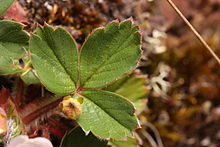Fragaria virginiana
| Fragaria virginiana | |
|---|---|

| |
| (Deception Pass State Park, Washington) | |
| Scientific classification | |
| Kingdom: | |
| (unranked): | |
| (unranked): | |
| (unranked): | |
| Order: | |
| Family: | |
| Genus: | |
| Species: | F. virginiana
|
| Binomial name | |
| Fragaria virginiana | |
| Synonyms | |
|
Fragaria ovalis (Lehm.) Rydb. | |
The Virginia strawberry, wild strawberry, or common strawberry (Fragaria virginiana) is one of two species of strawberry that were hybridized to create the modern domesticated garden strawberry. Its natural range is confined to North America, in the United States (including Alaska) and Canada, although a popular variety called "Little Scarlet" is grown only in Great Britain, having been imported from the United States in the early 1900s.

Subspecies
There are four recognized subspecies:
- Fragaria virginiana subsp. glauca (formerly known as F. ovalis)
- Fragaria virginiana subsp. grayana
- Fragaria virginiana subsp. platypetala
- Fragaria virginiana subsp. virginiana
Cytology
All strawberries have a base haploid count of 7 chromosomes. Fragaria virginiana is octoploid, having eight sets of these chromosomes for a total of 56. These eight genomes pair as four distinct sets, of two different types, with little or no pairing between sets. The genome composition of the octoploid strawberry species has generally been indicated as AAA'A'BBB'B'. The A-type genomes were likely contributed by diploid ancestors related to Fragaria vesca or similar species, while the B-type genomes seem to descend from a close relative of Fragaria iinumae. The exact process of hybridization and speciation which resulted in the octoploid species is still unknown, but it appears that the genome compositions of both Fragaria chiloensis and Fragaria virginiana (and by extension the cultivated octoploid strawberry as well) are identical.

